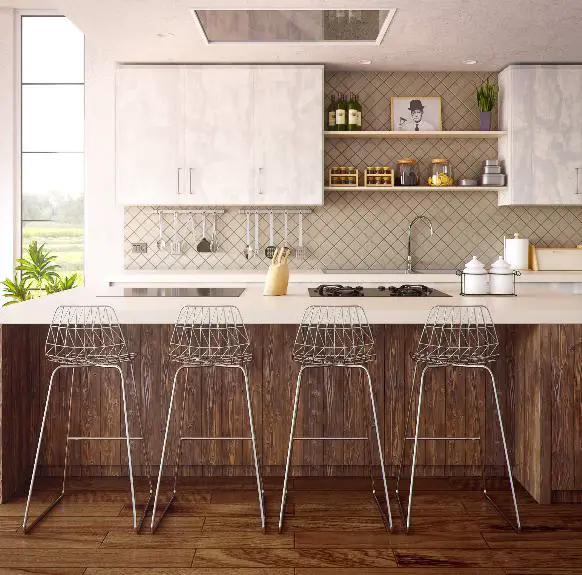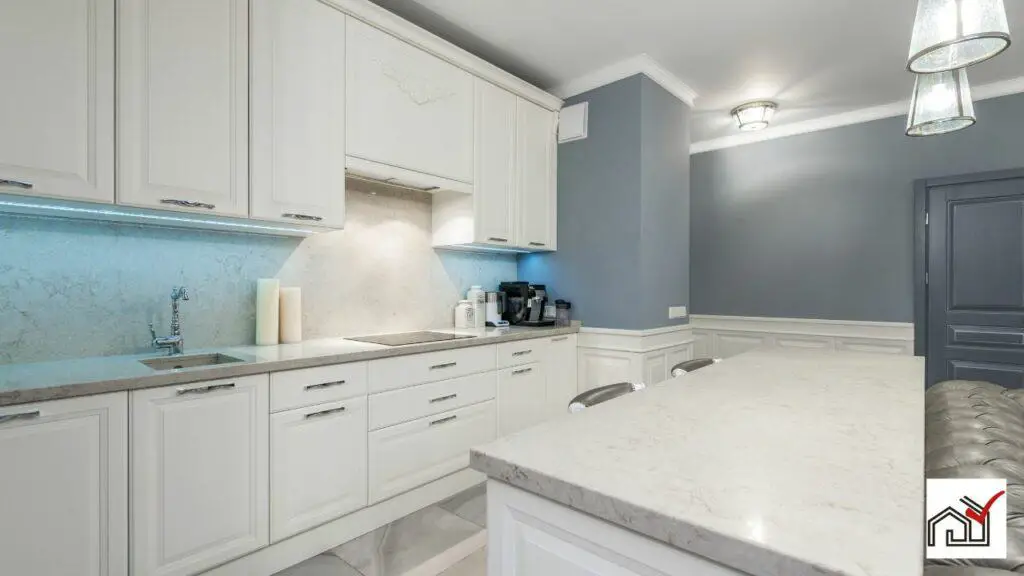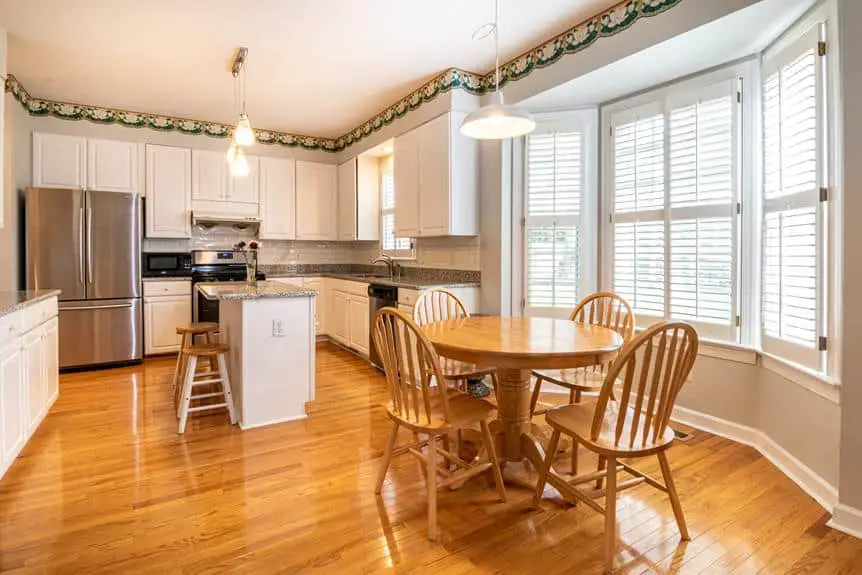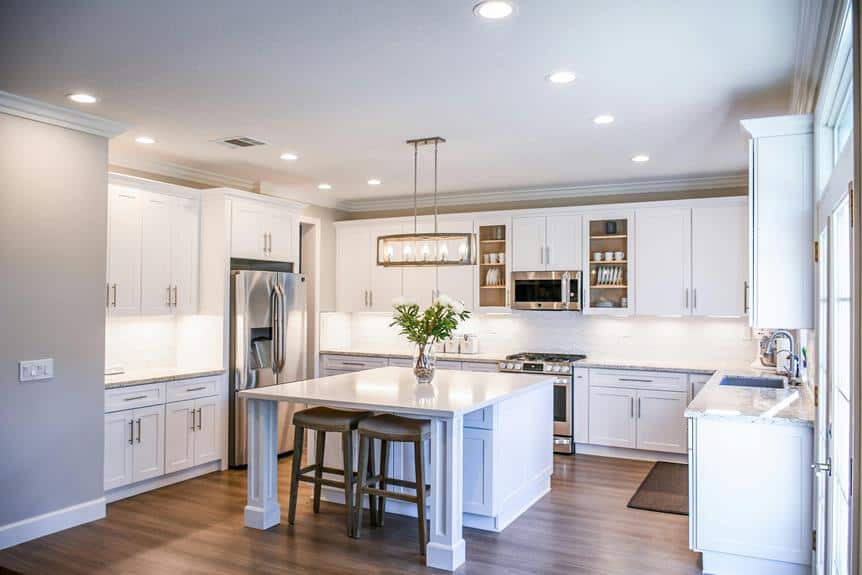Counter stools should be chosen to allow for 25 to 30 centimeters of space between the stool seat and the bottom of the counter for comfortable leg room.
Considering that standard counters are about 90 to 95 centimeters high, stools should typically have a seat height of 60 to 65 centimeters.
Adjustments might be necessary based on the exact height of the counter and individual comfort.
Understanding Counter Heights
Standard kitchen counters are typically 36 inches high, and the stools for these counters should have a seat height of 24 inches to provide comfort and allow the stools to fit under the counter. To determine the correct stool height, measure from the floor to the underside of the counter.
Bar surfaces usually stand at 42 inches high, requiring stools that are about 30 inches tall to maintain a 10 to 12 inch gap between the seat and the counter for ergonomic comfort.
For a counter that is 90cm high, stool heights should range from 65cm to 75cm to ensure a 15cm to 25cm clearance, accommodating different body sizes and allowing easy movement.
When choosing counter height stools, it's important to adhere to these standard measurements for functionality, comfort, and aesthetic harmony. For non-standard counter heights, adjustable stools or custom-made options can be considered, keeping in mind the recommended spacing and clearance for best use and appearance.
Ideal Stool Height Range
The ideal height for counter stools is between 65 and 75 centimeters, matching the standard kitchen counter height to allow comfortable seating without knees hitting the counter. The gap between the top of the stool and the counter should be 15 to 25 centimeters.
Bar stools should be taller, between 75 and 85 centimeters, to fit well with taller bar tables. The seat-to-bar clearance should be 20 to 30 centimeters for sufficient legroom and ease of access.
Spacing between stools is also important to avoid crowding and ensure comfort. The right spacing depends on stool width and the counter or bar's size, allowing for easy movement and a functional seating area.
Choosing the correct stool height and spacing ensures a comfortable and practical experience for users.
Measuring Counter to Stool
Measure the distance from the counter surface to the floor to find the correct stool height. Use a tape measure for accuracy.
The stool height should allow a six-inch clearance from the seat to the underside of the counter for legroom. For a 36-inch counter height, the stool seat should be 23 to 27 inches high.
Leave 8-11 inches between stools, especially if they are 19-22 inches wide or swivel, to avoid crowding and ensure easy movement.
Follow these guidelines for a comfortable and practical seating setup.
Stool Height and Comfort
Counter stool height is key for comfort. Choose stools with a height of 24 to 27 inches for standard 36-inch kitchen counters. Bar stools, on the other hand, should match taller 42-inch bar surfaces. Ensure enough space between stools, ideally 26 to 30 inches center-to-center, to prevent a crowded feel and allow for easy movement.
If your counter height is non-standard, consider adjustable stools for flexibility or custom-made options for a precise fit. For bar height counters, appropriate bar stools are necessary, or you might alter existing stools by cutting their legs to the correct height.
In essence, matching stool height and spacing to your counter or bar is crucial for a comfortable and welcoming environment. Proper selection and arrangement of stools contribute to both the look and functionality of your space.
Counter Stool Spacing
Proper counter stool spacing is essential for comfort and functionality in a kitchen. Stools should be placed approximately 15 to 20 centimeters apart. This spacing allows for sufficient personal space, enabling guests to sit and stand without interference and helps keep the kitchen orderly by allowing stools to fit under the counter when not in use.
It is not recommended to space stools more than 40 centimeters apart as it can hinder conversation and reduce the feeling of closeness during social gatherings, while also disrupting the visual harmony of the space.
Selecting stools with the correct height and spacing is crucial for a kitchen bar counter to be both practical and aesthetically pleasing, facilitating an environment that is welcoming for quick meals or extended socializing.
Impact of Stool Features
Counter stool designs affect user comfort and ergonomics in kitchens.
Swivel stools make getting on and off easier and improve interaction in social settings, especially in small areas.
Adjustable stools accommodate different counter heights and user statures, allowing for personalized comfort for dining or use with tall bars.
Backless stools save space but may not provide enough support for long periods.
The choice of material influences both appearance and longevity, while stability is crucial for safety.
It is important to consider these features when choosing stools to ensure comfort and suitability for the intended space.
Selecting the Right Style
There are many styles of counter stools available to match the look and function of your space. When choosing the right stool, consider how it will fit visually and practically in your dining area or breakfast bar.
Pay attention to the height of your counters and the style of your interior design. Explore different materials and designs to find stools that either blend with your decor or act as accent pieces. For example, a bar stool with an industrial design might suit a modern, urban space, while a vintage stool could add character to eclectic settings. Each stool offers a distinct size and historical feel.
The choice between backless and full-back stools is important for both the look and comfort. Backless stools save space by fitting under the counter, while stools with backs provide more support and can make a breakfast bar feel like a formal dining area.
Custom-made bar stools allow for specific counter heights and style preferences but may be more expensive. It's important to consider aesthetics, practicality, and budget when selecting a stool for your space.
Maintenance and Durability
Counter stools should be made from materials that are durable and easy to maintain, ensuring they last and provide comfort and support. The selection of materials and construction methods is important for durability. Customizable stools are built to withstand daily use and maintain their appearance.
In commercial environments, bar stools must be especially durable to handle constant use, movement, spills, and different weights. High-quality stools are essential for durability and low maintenance in such settings.
Vintage stools are valued for their proven durability and unique style. They add character and are a lasting choice for modern spaces.
Adjustable stools must be durable to handle frequent height changes without damaging their structure. It is important to choose stools designed for both adjustability and durability.
Stools with design or material rights reserved usually indicate high construction quality and ease of maintenance, making them a good investment for both home and commercial spaces.




